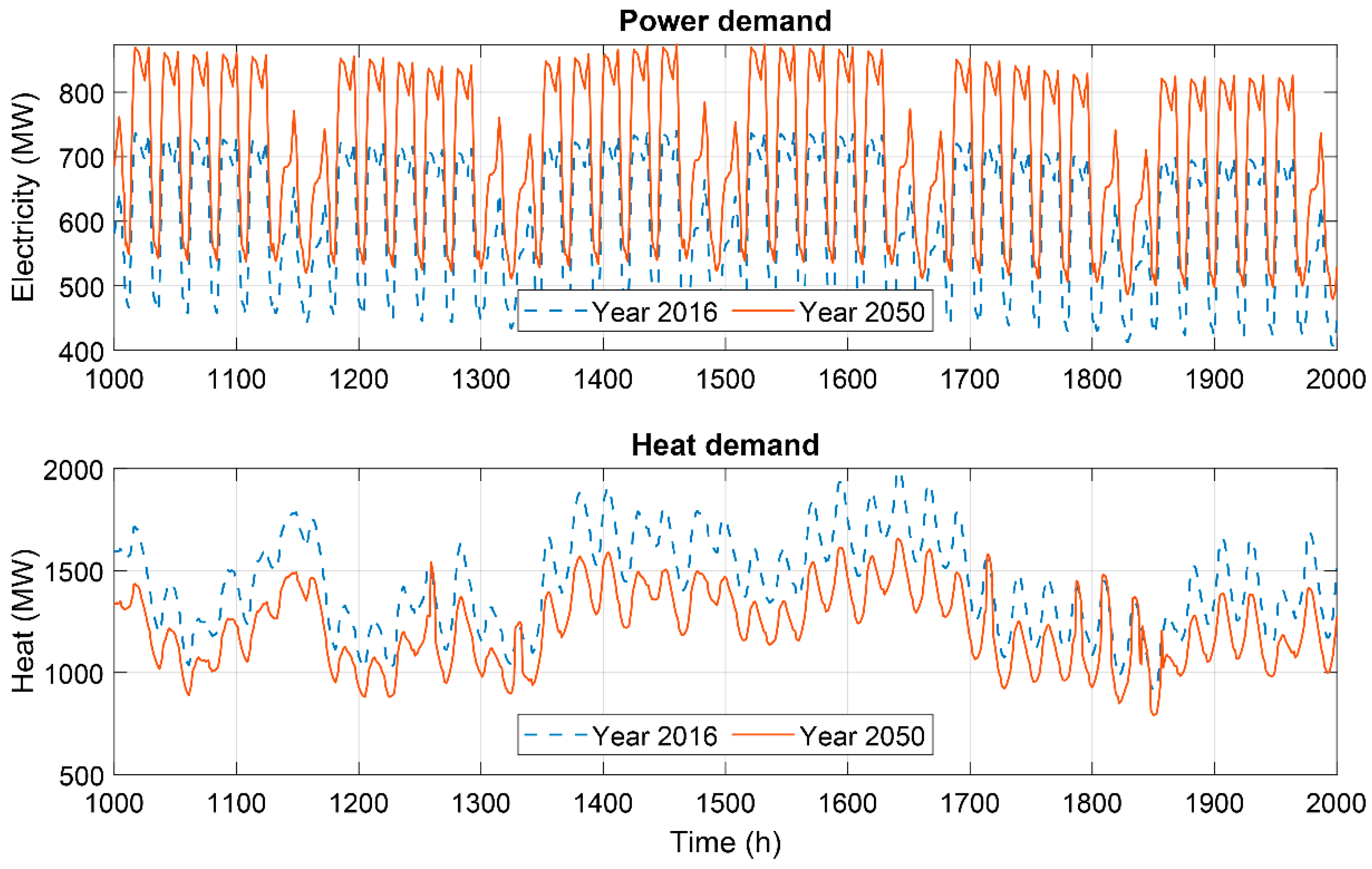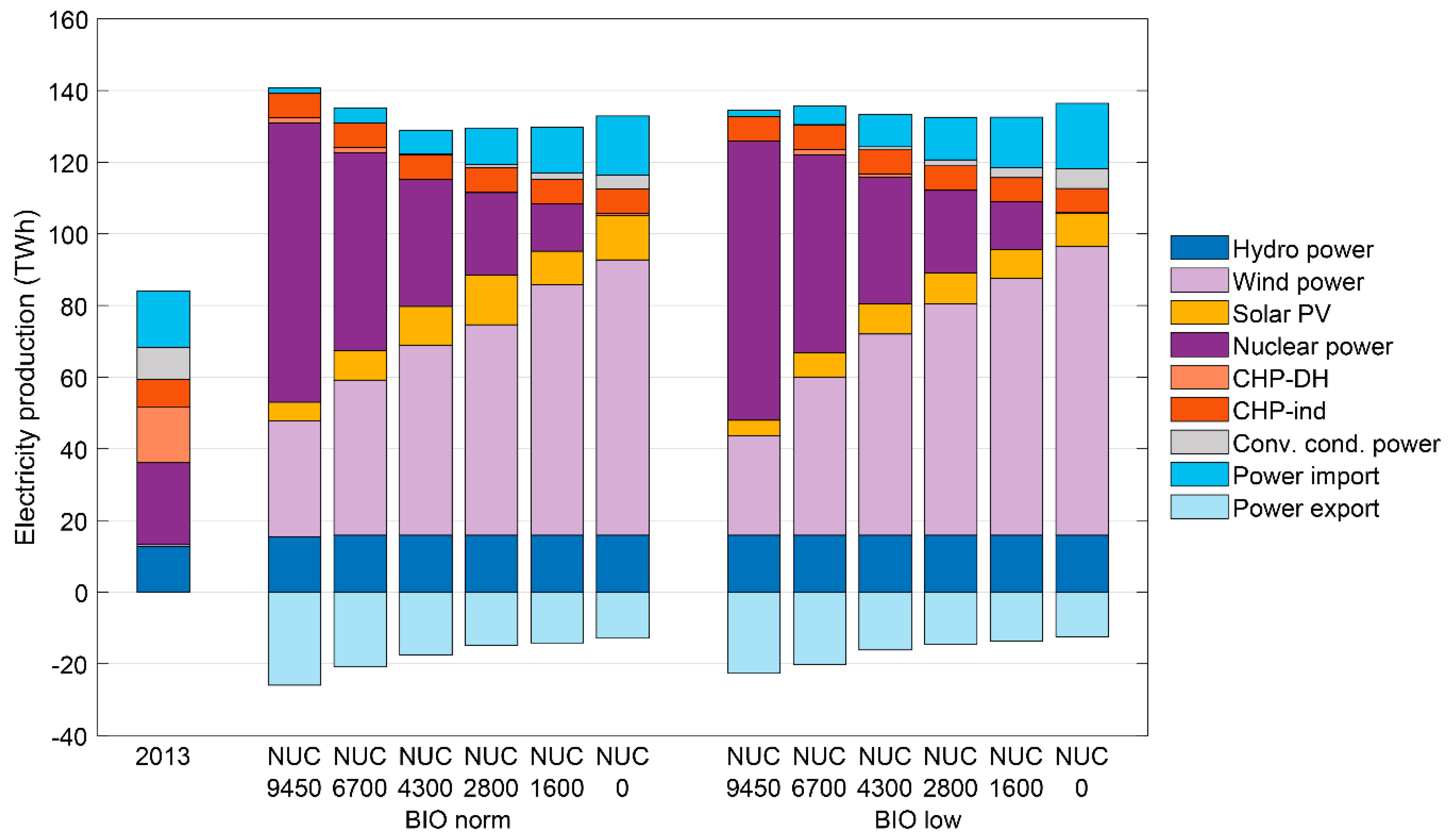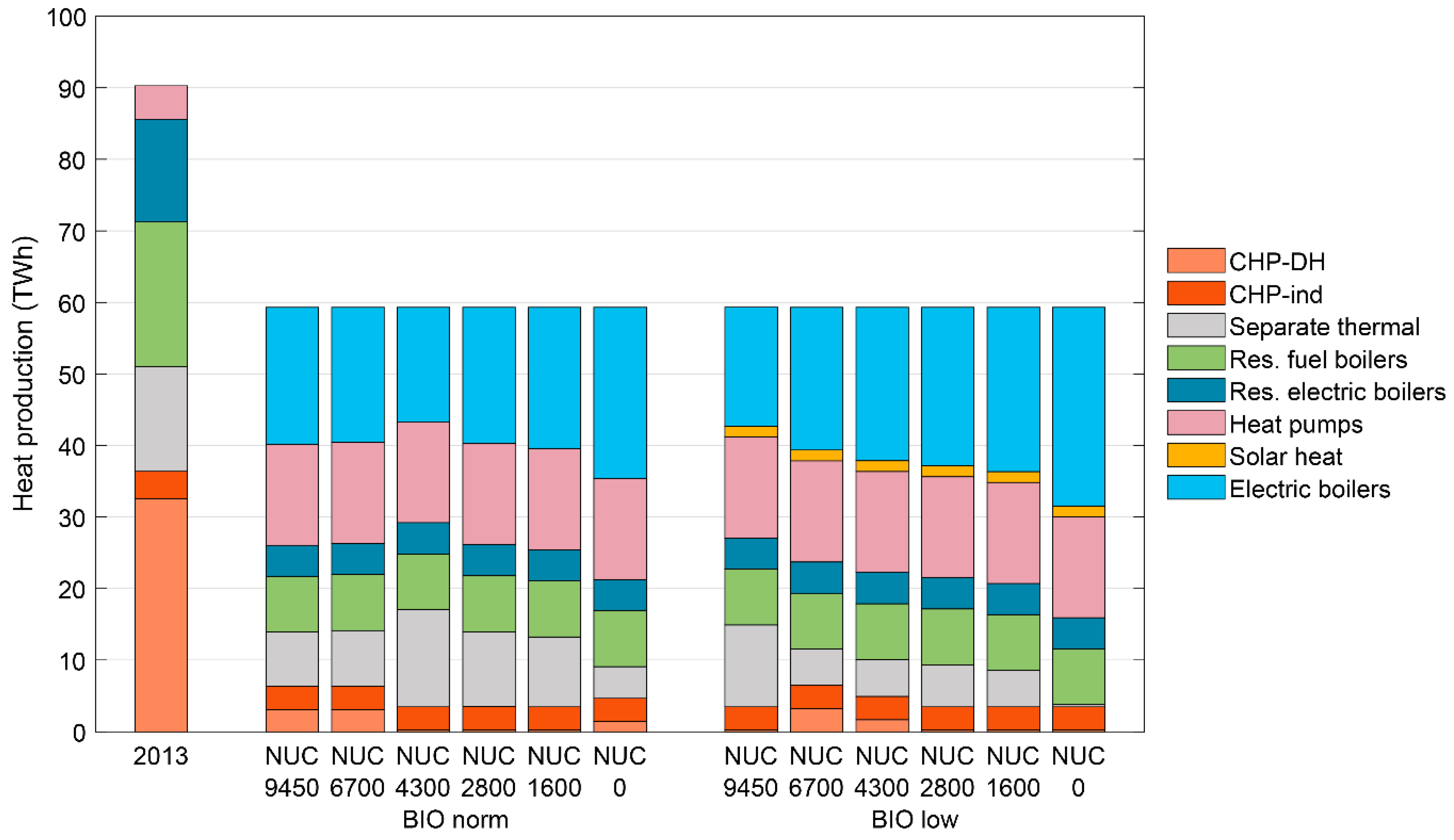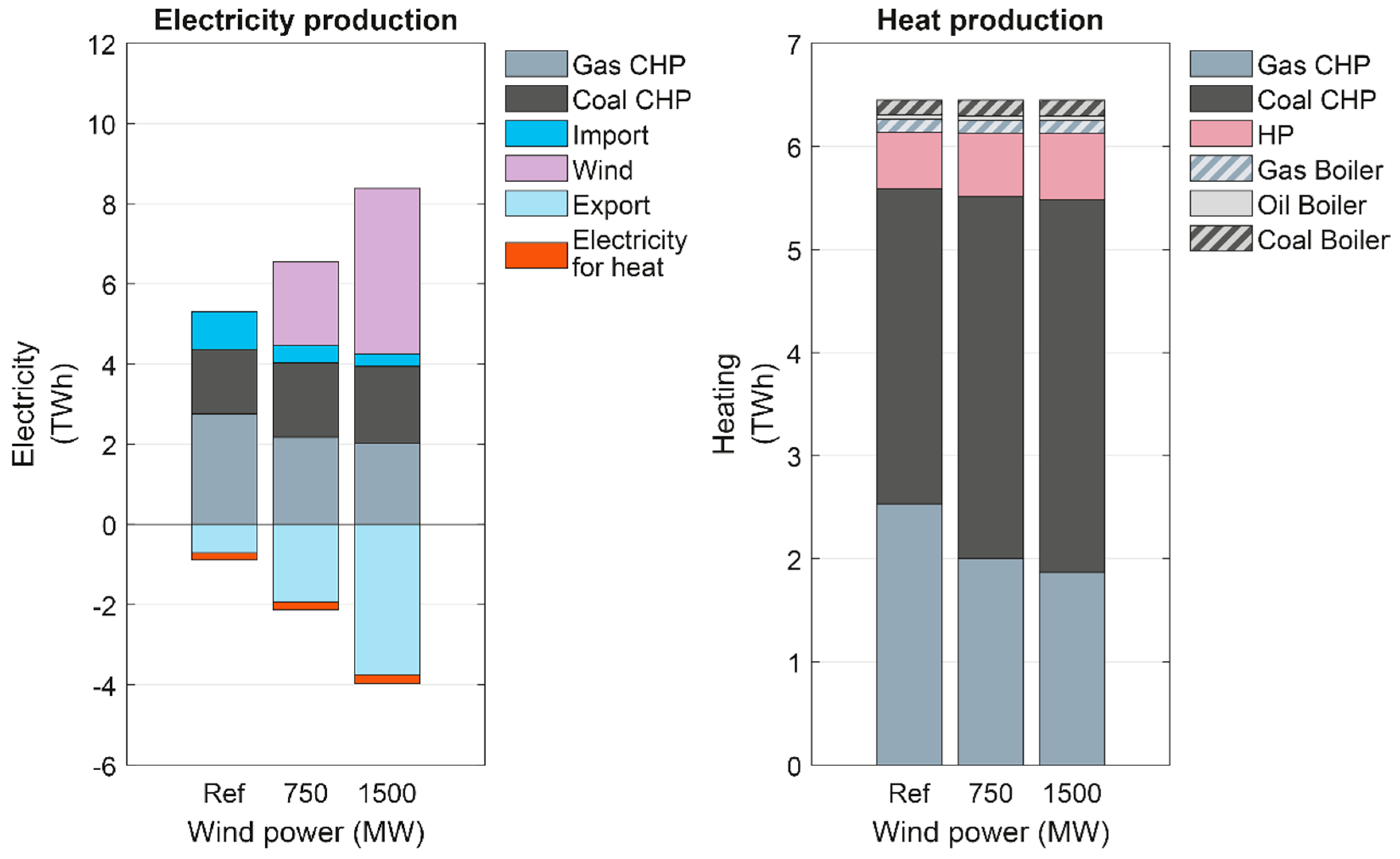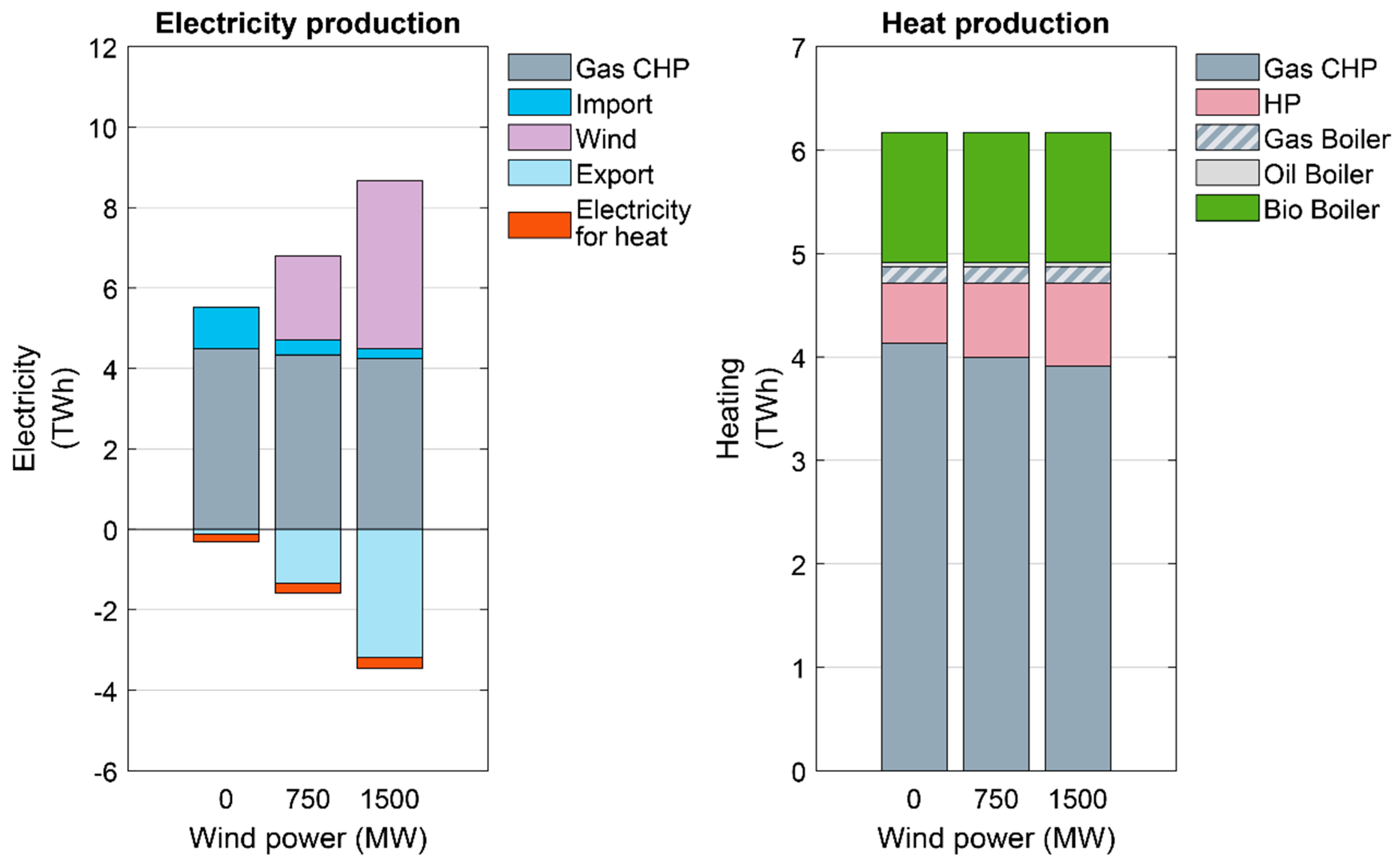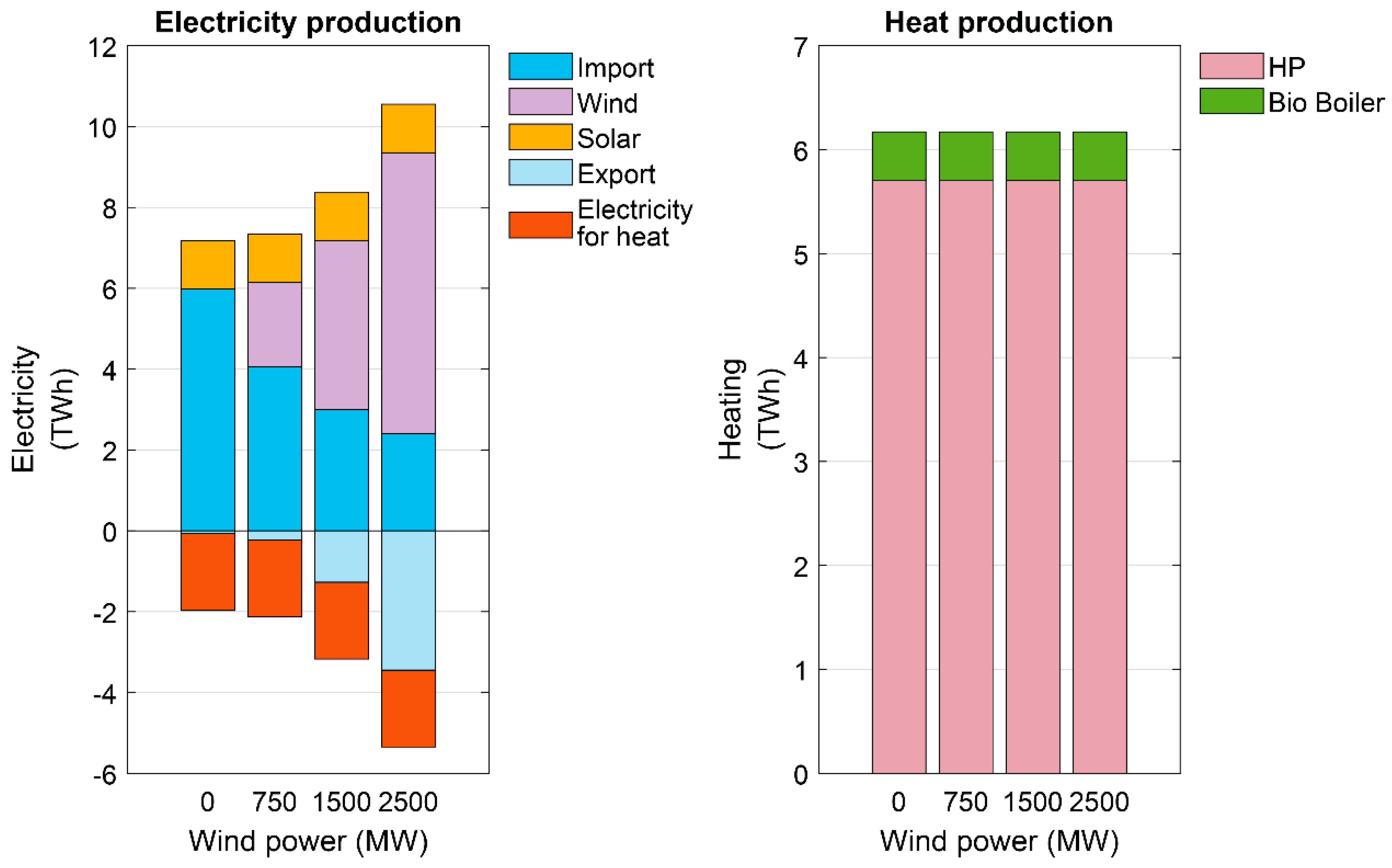1. Introduction
The recent report from the UN International Panel of Climate Change (IPCC) enforces the urgency to meet the emission targets set in the Paris Climate Accord from December 2015 [
1]. Basically, the whole energy production needs to be brought to carbon neutrality by 2050, i.e., sources and sinks of CO
2 emissions need to be in balance by then. Considering that 80% of global energy is still based on fossil fuels, the transition required to carbon neutrality will be a huge technological and societal challenge in the coming decades. The transition ahead touches all sectors of society and energy.
IPCC and the International Energy Agency (IEA) [
2] show in their future climate-energy scenarios that new and renewable energy technologies along with energy efficiency will play a major role in the up-coming sustainable energy transition. Around three-fourths of required emission reductions could originate from this ‘clean new energy’ pool. At the same time, recent market trends indicate that the variable renewable technologies, such as solar photovoltaics and wind power are taking increasing shares of new investments in power [
2], driven by the reduction of costs of new technologies which have led in cost-parity in major markets. Their future share is expected to even increase from the present level [
2]. Actually, solar and wind are often considered as the key technologies in energy change. The challenges with variable renewable electricity are well-known, ranging from the temporal mismatch challenge between supply and demand to increasing price fluctuations of electricity [
3,
4,
5], which will need innovative technological and systemic solutions.
In spite of these challenges, solar and wind power offer a highly potential alternative for the future not just for power production, but for the energy sector as a whole. Larger amounts of variable renewable electricity (VRE) could be integrated to the power system not only through large energy storage schemes, but also through sector coupling, i.e., coupling power to heating, cooling, mobility, gas, and other end-use sectors through power-to-X conversion (P2X, X standing here for the end-use or final form of energy) [
6]. In the case of P2X schemes, energy sectors (other than power sector) having inherent storage could participate in providing flexibility. The power-to-X has been extensively researched recently as part of the energy transition and in particular in connection with 100%-renewable energy systems [
7,
8,
9,
10].
A key focus of this paper is applying sector coupling to energy transition analysis, in particular power-to-heat (P2H) as a key technology for incorporating large-scale VRE schemes in a national and a city context, to also investigate the difference incurring from the size of spatiality (country–city). P2H is relevant as thermal energy actually dominates final energy use and as it is cheap and easy to store, e.g., in Finland 83% goes for household heating [
11], in Europe 80% [
12]. We use cold-climate cases Finland and Helsinki for our analyses, which offer further interesting perspectives, such as a trade-off between nuclear and renewables, limits of P2H for heating, a trade-off of forest bioenergy use between energy and CO
2 sinks, upper limits of VRE utilization, etc. These dimensions offer new perspectives to the issue of carbon-neutrality pathways. Also, Finland has among the highest CO
2 emissions per capita in the EU [
13]. The recent decisions of the Finnish government to ban coal for energy use and halve the oil use [
13] is a step in this direction with international relevance as well. We depict here technological pathways to carbon neutrality by 2050, analyzing the cases through three major framings, namely technologies, emissions, and resilience. We mainly focus on the power and heating sectors, but in the national analysis all end-use sectors in energy are included.
Carbon-neutral pathways has received increasing interest in literature, e.g., for Canada [
14], the US [
15], the UK [
16], Switzerland [
17], the Nordic countries [
18] and the EU [
10,
19]. Pathways to a carbon-neutral Finland have also been previously analyzed: Lehtilä et al. [
20] presented several pathways a low-carbon economy in Finland by 2050, whereas Child et al. focused on a 100%-renewable energy system in Finland [
21] and in the Åland islands [
22]. Zakeri et al. [
23] discussed the compromise between nuclear and wind power. However, these previous national studies have not considered energy system optimization while considering a wide range of nuclear power (both high and low) and limitations of biomass use. In addition, national-level and city-level pathways are hitherto rarely considered together in literature, which is the subject of this paper.
Cities’ role in the energy and environmental transition, whether based on IPCC’s emission mitigation, adaptation, or both strategies, is becoming a priority for local decision makers. Many cities world-wide have set goals to reach carbon neutrality already before 2050 [
24]. Strategies chosen include e.g., green energy schemes to cut CO
2 emissions or urban green zones to create carbon sinks. Previous work in this field for Helsinki include e.g., developing matching profiles for local decentralized energy production and consumption, optimization of local energy production, and wind curtailment schemes [
25,
26]. Essential technology improvements, such as electric vehicles, zero-emissions space heating, and carbon capture and storage for low-carbon pathways in cities have been analyzed for Beijing [
27], Tokyo [
28], Madrid [
29] and Mexico City [
30]. Advanced approaches to managing large renewable energy schemes have been studied for e.g., Shanghai and New Delhi [
31].
The clean energy transition means a radical change in energy sources and the whole energy system. This affects the security and risks of energy systems, but is often overlooked in energy pathway analyses. Traditionally, the International Energy Agency (IEA) has defined energy security through availability and affordability of energy sources [
32], but also further definitions are used, such as including accessibility and acceptability in the definition [
33]. Azzuni and Breyer defined energy security through optimal and sustainable functioning in all system dimensions, freely from any threats [
34]. Definitions and metrics are listed in reviews [
33,
34,
35].
As the energy transition includes profound changes in the whole energy system, broadening energy security to resilience issues will be highly important, discussed also in this paper. Resilience is defined through four ‘Rs’: Robustness, redundancy, resourcefulness, and recovery [
36,
37]. For example, the resilience of a decentralized power production system differs considerably from a centralized one against factors, such as geopolitics [
38,
39,
40], climate-change-induced extreme weather events [
41,
42,
43], or digitalization-linked cybersecurity [
44,
45]. We include here a systematic resilience analysis of the national and city-level clean energy pathway scenarios.
The paper is organized as follows. We first present the methods and tools used in our analysis, followed by presenting the input data and scenarios used in the analysis, followed by the key results and discussion and conclusions.
2. Methods
An energy transition involves several co-evolving systems such a techno-economic, socio-technical, and political system, which all need to be ‘optimally’ in place to enable a change into carbon neutrality [
46]. Often, as also in this paper, the focus is on the techno-economical system.
Therefore, our approach uses a modeling approach based on techno-economic optimization of the energy system. The mathematical task is to seek for a minimum-cost solution under different constraints and boundary conditions, originating from endogenous and exogenous factors. Two optimization models are included here: A macro-level model intended for national level analysis aimed at demonstrating carbon-neutral pathways for the energy system as a whole, and a micro- level model with more detailed description of the local energy system considering e.g., transient operation of the various power plants and how they interact on a short time interval. Instead of using a single model, the two scales of modeling (the whole national energy system with courser resolution, but all-inclusive in energy sectors, and a detailed closer to ‘real-time’ simulation of the energy system of a city) allow focusing on the investigating the dynamic and systemic effects of different options and degrees of freedom which may be different in a city and a country, and thus yield different outcomes for the pathways to carbon-neutrality. Finland is used as the case study for the national analysis and Finland’s capital Helsinki for the city-level analysis.
2.1. National-Level Model
The national-level energy system analyses are conducted with a macro-scale energy system simulation and optimization model, which is described in detail in Reference [
47]. The model incorporates all aspects of an energy system, including electricity, heat, and fuel; also, all end-use energy sectors are included. The model employs a one-hour time step for electricity and heat, while fuel demands are considered on an annual scale; the energy system is simulated on an hourly basis over a year to consider the dynamics and interactions of its different segments. The model seeks for a cost-optimal solution of the energy system while securing the supply–demand balance. The cost optimization problem is defined as
The optimization is subject to several conditions:
Balance of final energy supply and demand;
Available renewable energy resources;
Energy system constraints, e.g., cross-border transmission capacity;
Environmental constrains, e.g., CO2 emission target.
The variables in the optimization are the amounts of the primary energy sources, including renewable energy sources, and the amounts of different energy conversion technologies, such as combined heat and power (CHP), separate production, and heat pumps (HP). Also, more advanced final energy conversion paths can be considered: Power-to-X technologies (P2X), such as power-to-heat and power-to-gas, biomass-to-liquid (BTL), gas-to-liquid (GTL) and vehicle-to-grid (V2G). The energy system composition is thus endogenous to the model. The hourly distribution of the conventional production, such as CHP, is based on historical production data (2013) to mimic the hourly distribution, whereas the operation of power-to-X and other advanced conversion is rule-based. The main optimization outputs are the primary energy composition, power and heat production, and the energy balance of the system, while the main inputs are historical consumption and temporal data, cost assumptions, and system constraints, such as the cross-border power exchange capacity.
The model uses 2013 as the reference year for input data; a more detailed description of the input data can be found in Reference [
47]. The level of industrial CHP and residential heat production, which accounted for 43% of the heat demand in Finland in 2013, are assumed non-variable.
2.2. City-Level Model
The details of the optimization-based model for the city-level analysis are explained in Reference [
25]. The model simulates the operation of all energy plants of a city, in this case Helsinki, where more than 90% of the building stock uses district heating (DH). The optimization is based on one-hour-timestep simulations over a year using a mixed-integer linear programming (MILP) approach, written in Matlab code. The objective function of the optimization is given as
where
t stands for time and
i is the applied energy production technology. The model thus basically minimizes the running cost of a given energy system (OPEX) and its energy plants, whereas adding the annuity of the investments (CAPEX), as in the national model, would also enable optimization of a whole energy system. The latter option was not, however, relevant here as typically a city has already an existing system to which the new energy and variable renewable electricity (VRE) technologies are integrated. The running cost of thermal storage and power-to-heat conversion (P2H) were assumed negligible. The model considers three main constraint categories: Technical limitations of individual power plants, such as maximum power and heat outputs, ramping, start-up and shutdown times; limitations on system components e.g., power-to-heat conversion, storage capacity, and power transmission; and balance requirement between energy demand and supply.
For the 2050 analyses, the heat and electrical demand profiles were also modified from the reference case (2016) to reflect changes in population and building energy efficiency improvements. The mean building energy efficiency was assumed to improve by 20% from the 2016 level through better thermal insulation, heat recovery, advanced windows, thermostat control, etc. The domestic hot water (DHW) demand was scaled to perceived population changes in 2050 [
11]. The heat demand profile was modified using the following approximation:
where
U is the average U-value for the whole building stock,
stands for population,
= 17 °C considering the internal gains in the buildings,
α is the building energy efficiency improvements from the base year, 2016, and
is the hourly ambient temperature. The electrical demand is also altered based on population increment.
2.3. Resilience Assessment
The resilience assessment of the energy system focuses here on the technical robustness and versatility of the energy systems and their ability to cope with different disruptions. For this purpose, we developed a resilience matrix described in Tables 5 and 6. The values for the different resilience factors were obtained from the scenario calculations for the national and city cases, some factors were also assessed quantitatively by expert elucidation.
The resilience factors are grouped into the following categories. Environmental resilience is based on CO
2 emissions and the share of renewable energy in the primary energy. The sustainability of bioenergy is analyzed separately in a qualitative way considering possible effects on biodiversity. Power system resilience considers the robustness and flexibility of the power system infrastructure; the share of decentralized power production and supply adequacy during peak demand are considered as well. Supply adequacy is defined as a ratio between the total production capacity and the peak demand—the effect of VRE is considered via its yearly capacity factor (excluding the production that exceeds the demand) to account for its temporal variability and actual contribution in demand coverage. For power system flexibility methods, hydropower, P2H, and vehicle-to-grid (in national case only) are considered here. The heating sector is analyzed separately, due to its high importance at high latitudes. Factors included in the analysis are the robustness of the (district) heating networks, share of decentralized heat production, total heat production capacity vis-à-vis peak heat demand, and heat storage capacity. The resilience category ‘system independence and geopolitics’ both in case of electricity and heating was more related to traditional energy security emphasizing energy self-sufficiency to mitigate possible geopolitical threats and to secure local energy supply in crisis situations. In this category, the imports of electricity and fuels and the diversity of primary energy sources are considered. The level of diversity is defined with the Shannon–Wiener diversity index (SWDI) [
48,
49]:
where
is the share of the energy source
e in the total primary energy supply.
5. Conclusions
In this study, we have analyzed low-carbon and carbon-neutral scenarios simultaneously for a country (Finland) and a city (Helsinki) for 2050, with interest in possible systemic differences in solutions and consequences. Both cases were handled with different energy system models based on techno-economic optimizations: The national-level model focused on macro-scale optimization incorporating all aspects of an energy system, including electricity, heat, and fuel, while the city-level model optimized in detail the operation of a local energy system with all energy plants. Both models include options for energy system flexibility, such as power-to-heat and thermal energy storage. In addition, we assessed the energy system resilience in the national and the city-level scenarios as this may change with energy system developments.
In the national case, the results indicate that wind power, nuclear power, and biomass, coupled with power-to-heat and other flexibility measures, could provide a carbon-neutral pathway, but nuclear and wind are, to some extent, exclusionary. There seemed to be a trade-off between the levels of nuclear and wind power, though with our cost assumptions, the national system’s annual costs seemed to be insensitive to the level of nuclear power. In the Helsinki case, a large wind-power scheme combined with heat pumps and biomass boilers could help to transform the current fossil-fuel-based energy system into a carbon-neutral one. On both levels, (near) carbon-neutral energy system would seem possible, even without any nuclear power on the national level. Large-scale wind power integration, however, requires more interaction with the Nordic power market, due to increased temporal mismatch of power supply and demand. For Helsinki case, without any flexibility means incorporating large-scale wind power would lead to high power exports, meaning that the wind power would less replace fossil fuels. This is mostly due to the high heat demand which requires running the fossil-based CHP plants, even when wind power production would be plentiful. In the national scenarios in particular, leaning in large-scale on forestry biomass may include some future risks, if its use had to be limited due to sustainability concerns. In such a situation, reaching carbon neutrality could not be reached without expanding e.g., wind power with P2G.
Due to the role of heating in the final energy in northern climates, reaching overall carbon-neutrality in energy production would require special attention on heat production. Our results indicated that electrification of heat production could be an effective way to reduce CO2 emissions on both city and national levels and to provide the required flexibility to the energy system. On the national level, power-to-heat schemes to generate CO2-free heat are powered by a mix of zero-carbon energy sources, i.e., nuclear, wind and (to a lesser extent) hydro and solar power. Power import would reduce on the national level, but increasing nuclear power in particular expands power export. Our analysis indicates also that striving for zero-carbon energy production as a whole would benefit from a strong link to the electricity market to compensate for increased energy mismatch albeit introducing energy system flexibility measures. This would actually be more pronounced on the city level with less spatial smoothing effects.
The low or zero carbon energy solutions in the scenarios have a positive impact on resilience from an environmental and power system point of view: CO2 emissions are radically lower from the present level, the share of local (decentralized) power production increases and the grid infrastructure is strengthened. Furthermore, geopolitical threats decrease as the dependence on foreign imports diminish with increasing renewable energy utilization. However, the resilience improvement of the heating sector is more problematic, as even though the role of local heat production strengthens, the electrification of heat supply poses new kind of threats, such as power outage and adequacy of supply during peak demand, which may require further attention in planning future carbon-free energy systems.
